The story of Game 7 between Carolina and New York was as it had been for much of the Rangers' season: the power play and Igor Shesterkin. There were four power plays in the first period, two for each team, but the Rangers went 2/2 where the Hurricanes went 0/2, and Igor shut the door everywhere else.
Carolina suffered a couple key injuries, too. Seth Jarvis took this hit from Jacob Trouba and left the game:
In the second period, goalie Antti Raanta stretched for an awkward saved and was injured as well. He also left the game, not to return, and turning the net over to Pyotr Kochetkov. In the same frame, Ryan Strome tallied to extend the lead to 3-0, a lead that would hold for the rest of the game. ending in a 6-2 final. New York has advanced to the Conference Final for a matchup with Tampa Bay.
When we get further updates on the injured players, we will relay that information.
The series with the Lightning should be interesting, if not the least for the goaltending matchup between Shesterkin and Andrei Vasilevskiy. We will have our Dobber Panel with our picks on the site shortly, too.
*
My favourite topic to research and write about in fantasy hockey is, without a doubt, defencemen. Just the way the position has evolved since I started writing about the NHL a decade ago has been fascinating to watch. Not to put it all on one player, but I wonder how many under-25 defencemen we have in the NHL now that grew up marvelling at what Erik Karlsson did with the puck. It would be an interesting study/survey, but I digress.
Nonetheless, talking defencemen is what we're going to do here today. We're going to review the season of a couple blue liners and what it could tell us for 2022-23. Let's start with one of the top young defencemen in the game who gets less ink than some of his contemporaries. (Data from Natural Stat Trick and our own Frozen Tools, unless otherwise noted.)
It might not feel like it, but Heiskanen set a career-best in points this year with 36 (in just 70 games). This means he's paced for over 40 points/82 games in three straight seasons now. He has 98 points in his last 193 regular season games, or roughly 42 points/82 games in that three-year span. That might not seem superb, but he did that in his age-20, age-21, and age-22 seasons. It seems like he's a grizzled veteran at this point and he doesn't turn 23 until July. We should also note that just 29 of those 98 points came with the man advantage, or a shade under 30%. For reference, Adam Fox is at 42.3% for his career, with Cale Makar at 41.7% and Quinn Hughes at 46.7%. Other young star blue liners in their early-20s are getting lots of power-play time on the top unit, and Heiskanen is not. That persisted in 2021-22 where Heiskanen had a shade over 150 total PP minutes (well, at 5-on-4 anyway), and just 28 of them on the top unit. Conversely, teammate John Klingberg had roughly 195 PP minutes and 167 of them were on the top PP unit. The top PP unit scored nearly 10 goals per 60 minutes; the second unit was closer to 6.5. Not bad, in reality, but the gap means a lot to a defenceman. We'll get back to this in a second.
As for Heiskanen's actual performance, he was elite. From HockeyViz, we can see how the opposition struggled to generate anything from the slot when he was on the ice:
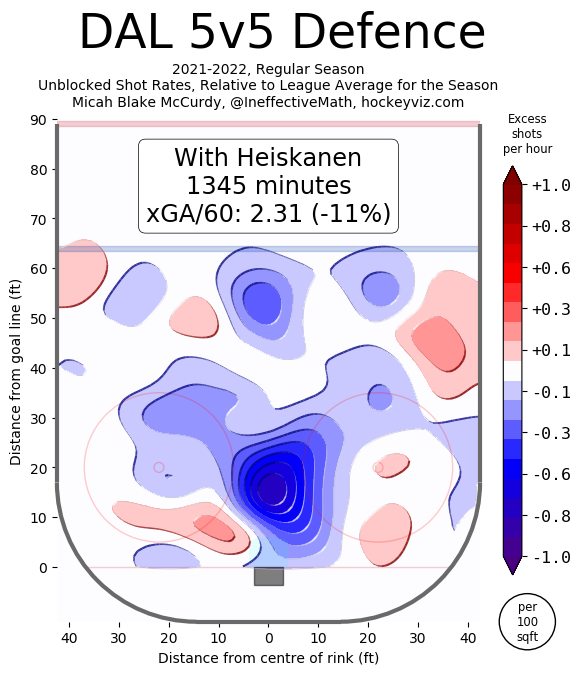
The team was not nearly as clean defensively with him off the ice, and that made him a huge difference-maker on the back end. Fantasy owners don't get points for good defence but being able to limit the opposition and get the puck moving in the other direction helps create offence. To that end, we can check Corey Sznajder's micro-stat tracking (Patreon here) to see how he helped in transition. Here are all Dallas defencemen, and the unlabelled player way to the right is the Finnish rearguard:

I added a couple labels of other defencemen who had similar possession entry rates as our guy Miro, for comparison's sake. He did a great job of getting into the zone with the puck, with only a few guys in the league surpassing him.
The problem is the Y-axis, where we see scoring chances generated off those entries. The entire Dallas team struggled, and though he was above average, he was well below the elite in the NHL like Makar, Hedman, and Chabot. (Shout out to Dmitry Orlov, Adam Boqvist, and Jake Walman, who all had great seasons in both regards and are much less heralded.) That probably doesn't come to much of a surprise for anyone that watched Dallas this year. When the top line was on the ice, things were great. But with the top trio off the ice at 5-on-5, expected goals and scoring chances fell by 33%, and actual goal scoring fell by 57%. The depth from the Stars was a big issue for them all season, and if that doesn't improve, Heiskanen's upside is capped.
So, the Stars' star was great defensively (we expected that) and he was great in transition, even if his team struggled with their top three scorers on the bench. What about his shooting? This is where another issue pops up.
For 2021-22, Heiskanen finished 64th out of 170 defencemen with at least 800 minutes at 5-on-5 in shot attempt rate, in the same range as names like Chad Ruhwedel, Marcus Pettersson, and Jan Rutta. Not really great company. The twist here is he had 0.29 individual expected goals per 60 minutes, tied for 20th in the league with Hedman and Noah Hanifin. His shot quality improved from the prior season and was in line with his first couple years in the league. The problem was he shot – and this isn't a typo – 0.9% at 5-on-5. He had one goal on 119 shots, which feels absurd. He had shot 4.4% over his first three seasons which, had he shot that in 2021-22, would have led to five goals at 5-on-5 instead of one. It would have been enough to push him over 40 points for the first time in his career, and I wonder what the conversation would be had he done that. We should expect that to regress positively next year, and that means he'll threaten double-digit goals.
The crux in all of this is the aforementioned Klingberg. It appears he's played his last game for the Stars, and that opens a role on the top PP unit. Over the last two seasons, the top unit has generated 71 scoring chances/60 minutes with Heiskanen on there, and 62 scoring chances/60 with Klingberg. They scored more with Klingberg, but the gap of 10.6 goals/60 with the soon-to-be former Star to 8.3 with Heiskanen isn't huge, and the latter has a much smaller sample (under 50 minutes). Dallas generates basically the same types of shots with either, so we could see Heiskanen slide seamlessly into the that role. It wouldn't be surprising to see him double his PP output of 11 PPPs and that, combined with the goal-scoring regression, means 50 points is in play.
We are seeing the emergence of a perennial Norris contender, and he's set to assert himself on the top power play quintet. There are still issues with his peripherals (especially hits), but 50 points is a reasonable target for the soon-to-be 23-year-old in 2022-23.
He is a little bit older, but at the age of 25 (he'll be 26 early in 2023), Chabot is in his prime for production. He had an injury-ravaged 2021-22, but still showed why he'll be an elite point producer in this league. That viz pasted above with Heiskanen's zone entry rates? See that Ottawa logo way at the top? It’s labelled for a reason. No defenceman in the league had more scoring chances generated off his zone entries this season than Ottawa's number-1 blue liner.
There are two issues to discuss here. First is his own defence.
Chabot's issue is he's just not great defensively, and certainly not in Heiskanen's realm. Again, from Sznajder's data, we can see how many scoring chances were generated against Chabot off zone entries:
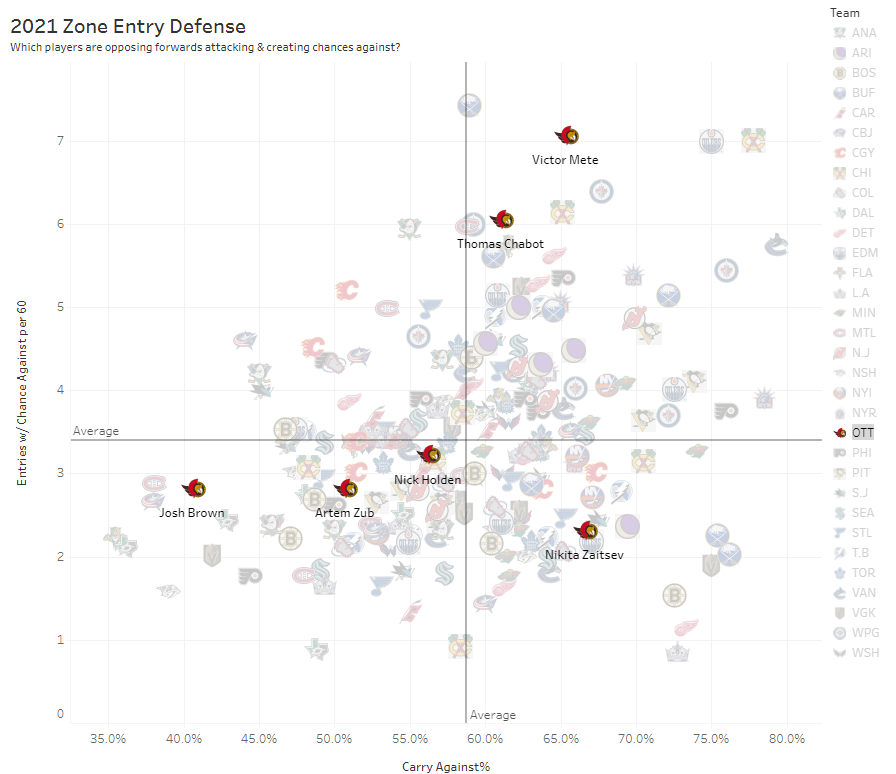
There weren't many defencemen in the league who allowed more scoring chances against off zone entries against them; we're mostly looking at depth defencemen from non-playoff teams like Logan Stanley (WPG), Henri Jokiharju (BUF), and Erik Gustafsson (CHI). Unlike Heiskanen's scoring chance generation problem, this isn't a team-wide issue, as we see a number of Ottawa defencemen below the league average in chances against. The opposition doesn't have a big problem entering the zone against Chabot, and then the defensive problems compound after that. Having to constantly play defence in your own end is bad for generating offence the other way, relying much more on counter-attack rush offence than controlled play. That can lead to goals, sure, but not sustained pressure.
The other problem is similar to Heiskanen's in that Ottawa struggles to score with the top line off the ice. There were injuries that the top trio went through, but with all three of them off the ice, scoring dropped 37%. And when one of the top guys was injured, scoring dropped at similar (if not higher) rates. A full, healthy season from Drake Batherson, Brady Tkachuk, and Josh Norris, combined with a Tim Stutzle breakout, would go a long way to improving Chabot's production. If they somehow acquire more depth scoring, all the better.
Let's not get it twisted here, Chabot still had a good year, if abbreviated. He paced for 53 points/82 games and did so getting roughly one-third of his points from the power play. Remember that the elite young guys we talked about earlier were all over 40%, so the power play is the next problem to solve. The top unit scored 7.6 goals/60 in their time together, which isn't awful, but New York's top unit was at 10.9, with Vancouver at 9.5 and Colorado at 9.4. An extra two goals/60 minutes, getting over three minutes at 5-on-4 per game, could lead to an extra 6-7 PPPs, and that doesn't include improvements at 5-on-3 or 4-on-3. The power play has to get there first, though.
Chabot had excellent personal expected goal and shot rates, which bodes very well for double-digit goal scoring moving forward. The issues of his defence, the power play, and team scoring depth are the things holding him back from going from a 50-point defenceman to a 65-point defenceman. He has all the offensive skills to do it, but other areas of his game (and the team's composition) need to catch up to those skills.

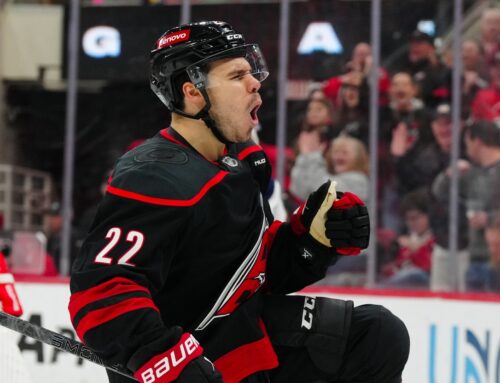
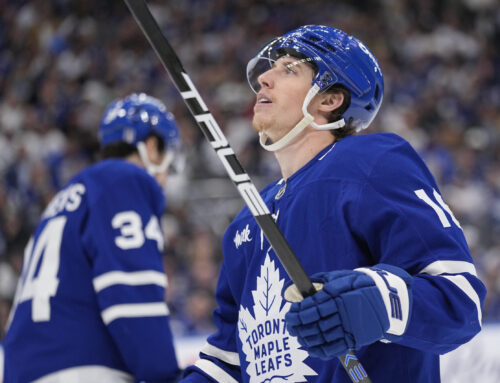
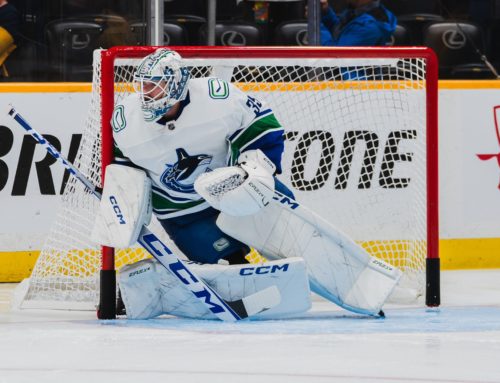


 MIN
MIN MTL
MTL PHI
PHI COL
COL CHI
CHI ANA
ANA N.J
N.J
